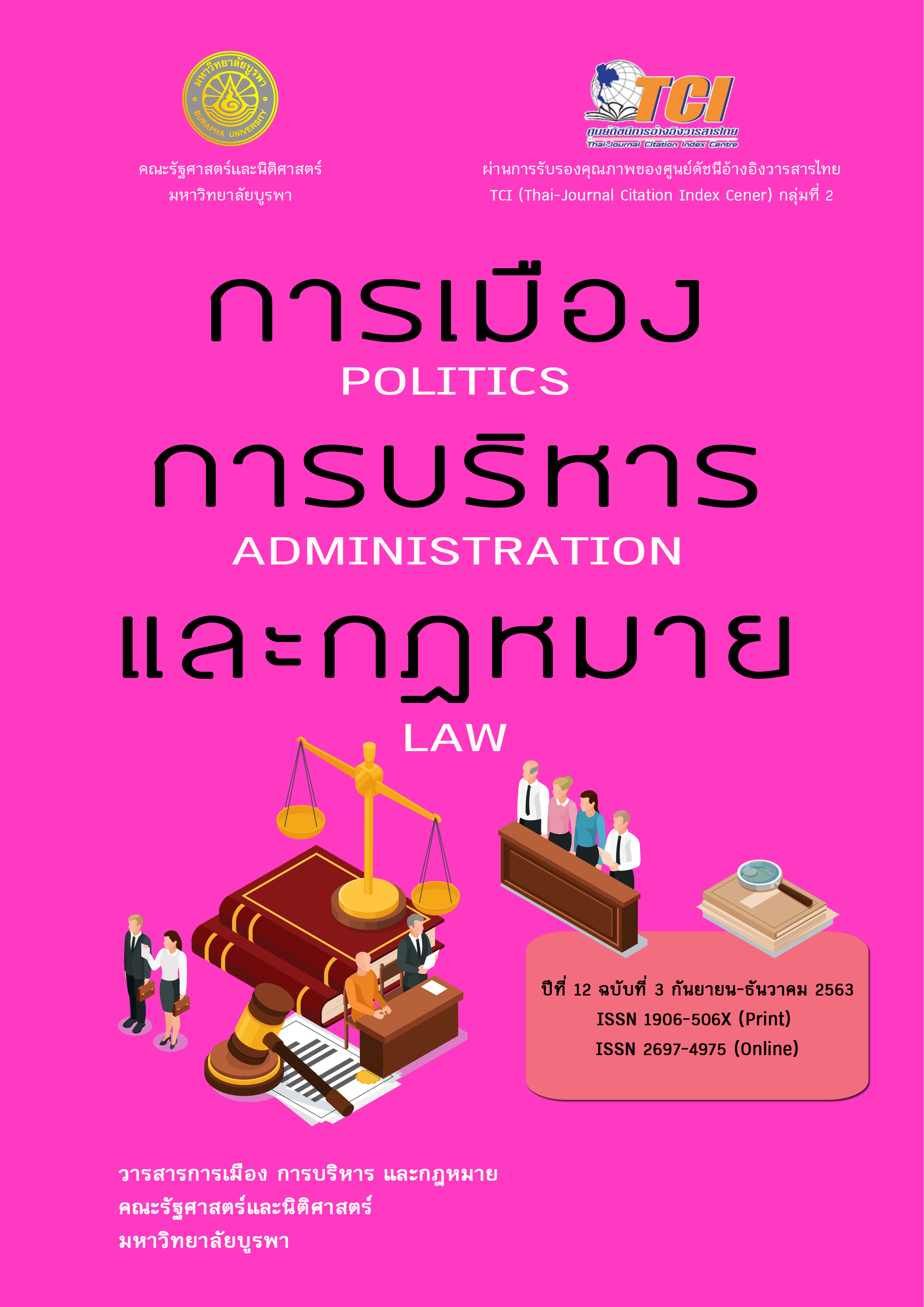Legal Measures on Electronic Monitoring Punishment for the Rehabilitative Offenders in Thailand
Keywords:
Electronic monitoring, Punishment, Rehabilitative offendersAbstract
The objective of this research was to study the theories, concepts and the origin of the use of electronic monitoring (EM) in the criminal justice system, including Thai and foreign laws relating to the use of electronic monitoring. The problems of the enforcement of electronic monitoring in Thailand were also studied and analyzed in order to obtain a summary and recommendations for the proper use of electronic monitoring in Thailand. This research is a qualitative research. Documentary research was done by studying textbooks, articles, theses, journals, legal theories, as well as information on the internet, etc. It was found that there are legal issues of the use of electronic monitoring in the criminal justice procedure in Thailand, such as the issue of prisoner classification and the enforcement of EM in accordance with the Criminal Code, the consent of the offender or the defendant, temporary release from prison by using EM, poverty, criminal measures and penalties for those who destroy the device, and data violations in the operating system of electronic monitoring. The researcher concluded that the determination of alternative measures, other than imprisonment and fines, gives the defendant the opportunity to correct his guilt and create awareness on his offense. This is the rehabilitation of offenders without detaining them in prisons. The court may, more appropriately, use its discretion to await imposition or await penalty. The court can determine the conditions for probation of the offenders by using electronic monitor as a legal measure. This is useful and in accordance with the context of the criminal justice process. However, the researcher suggested to amend the laws related to the use of electronic monitoring. In the probation process of the offenders with serious sexual offense, electronic monitoring shall be used if that person causes a serious danger to society. After the judgment, for non-serious cases, the defendant has the right to file a petition to the court to consider the use of electronic monitoring instead of imprisonment. In the process of releasing prisoners, the defendant has the right to file a request for suspension to the prison commander to remove the electronic monitoring.
References
ณัฐฐ์วัฒน์ สุทธิโยธิน. (2554). เอกสารทฤษฎีการลงโทษ แนวการศึกษา ชุดวิชากฎหมายอาญาและอาชญาวิทยาชั้นสูง หน่วยที่ 6. นนทบุรี: สาขาวิชานิติศาสตร์.
ฐิติมา ประเสริฐ. (2553). การจำคุกในสถานที่อื่นที่ไม่ใช่เรือนจำ. วิทยานิพนธ์ปริญญามหาบัณฑิต, คณะนิติศาสตร์, มหาวิทยาลัยธรรมศาสตร์.
ไทยรัฐออนไลน์. (2562). เปิดไส้ใน “กำไล EM” ผลิตจากอะไร ใช้ของใกล้ตัวตัดสะบั้น วินาทีหั่นไม่มีใคร รู้. วันที่ค้นข้อมูล 31 มกราคม 2562, เข้าถึงได้จาก https://www.thairath.co.th/content/1482896
ไทยรัฐออนไลน์. (2562). ยกเลิกกำไล EM ยุติธรรมปรับเงิน 83 ล้าน 541 คนให้ใช้ของศาลไปก่อน. วันที่ค้นข้อมูล 23 กันยายน 2562, เข้าถึงได้จาก https://www.thairath.co.th/news/local/1665453
ปิยะพร ตันณีกุล. (2559). แนวทางพัฒนาการนำระบบการควบคุมตัวอิเล็กทรอนิกส์มาใช้กับผู้กระทำผิดในประเทศไทย. วารสารสังคมสงเคราะห์, 24(2), 121-149.
ประธาน วัฒนวาณิชย์. (2546). ความรู้เบื้องต้นเกี่ยวกับอาชญาวิทยา. กรุงเทพฯ: สำนักพิมพ์ โฟร์พริ้นติ้ง จำกัด.
ประธาน วัฒนวาณิชย์. (2561). ทางเลือกการลงโทษ การลงโทษระดับกลางและการแก้ไขผู้กระทำผิดในชุมชน. หนังสือที่ระลึก 60 ปี พี่ใหญ่ ใจหาญ คณะนิติศาสตร์ มหาวิทยาลัยธรรมศาสตร์. หน้า 243-260.
วิชัย ลีลาสวัสดิ์. (2557). การนำเครื่องมือติดตามตัว (Electronic Monitoring) มาใช้กับผู้ถูกคุมความประพฤติในศาลแขวงพระนครเหนือ. กรุงเทพฯ: สถาบันพัฒนาข้าราชการฝ่ายตุลาการ ศาลยุติธรรม.
สุพจน์ สุโรจน์, ลาวัลย์ หอนพรัตน์ และณัฐวัฒน์ สุทธิโยธิน. (2554). ทฤษฎีการลงโทษและทฤษฎีวิธีการเพื่อความปลอดภัย. วันที่ค้นข้อมูล 5 พฤษภาคม 2562, เข้าถึงได้จาก http://law.stou.ac.th/dynfiles.pdf
สื่อศาล. (2562). วันที่ค้นข้อมูล 7 ตุลาคม 2562, เข้าถึงได้จาก https://www.facebook.com/pr.coj/photos/a.122051428496860/426542944714372/?type=3&theater
ศุภกิจ แย้มประชา. (2558). มองกระบวนการยุติธรรมทางอาญาไทยผ่านการศึกษาเปรียบเทียบ (The Thai Criminal Justice System: A Comparative Perspective). กรุงเทพฯ: ห้างหุ้นส่วนจำกัด เจริญรัฐ การพิมพ์.
อัจฉรียา ชูตินันทน์. (2557). อาชญาวิทยาและทัณฑวิทยา (พิมพ์ครั้งที่ 2). กรุงเทพฯ: สำนักพิมพ์วิญญูชน.
Aebi, M. F., & Marguet, Y. (2014). SPACE II: Council of Europe Annual Penal Statistics: persons serving non-custodial sanctions in 2012. Strasbourg: Council of Europe.
Beyens, K., & Roosen, M. (2013). Electronic Monitoring in Belgium: A Penological Analysis of Current and Future Orientations. European Journal of Probation, 5, 56-70.
Bülow, W. (2014). Electronic Monitoring of Offenders: An Ethical Review. Science & Engineering Ethics, 20(2), 505-518.
Erez, E., & Ibarra, P. R. (2014). Electronic monitoring: international and comparative perspectives. Crime, Law and Social Change, 62(4), 385-387.
Haverkamp, R. (2014). Electronic Monitoring. In G. Bruinsma & D. Weisburd (Eds.), Encyclopedia of Criminology and Criminal Justice (pp. 1329-1338). New York, NY: Springer New York.
Haverkamp, R., & Woessner, G. (2016). The Emergence and Use of GPS Electronic Monitoring in Germany: Current Trends and Findings. Journal of Technology in Human Services, 34(1), 117- 138.
Kilgore, J. (2013). Progress or More of the Same? Electronic Monitoring and Parole in the Age of Mass Incarceration. Critical Criminology, 21(1), 123-139.
Lilly, J. R. (2014). The 2014 Council of Europe recommendation on electronic monitoring: an American perspective. Crime, Law and Social Change, 62(4), 511-513.
Nellis, M. (2014). Understanding the electronic monitoring of offenders in Europe: expansion, regulation and prospects. Crime, Law and Social Change, 62(4), 489-510.
Sainju, K. D., Fahy, S., Hamilton, B. A., Baggaley, K., Baker, A., Minassian, T., & Filippelli, V. (2018). Electronic Monitoring for Pretrial Release: Assessing the Impact. Federal Probation, 82(3), 3-10.
Weisburd, K. (2015). Monitoring Youth: The Collision of Rights and Rehabilitation. Iowa Law Review, 101, 297-341.






